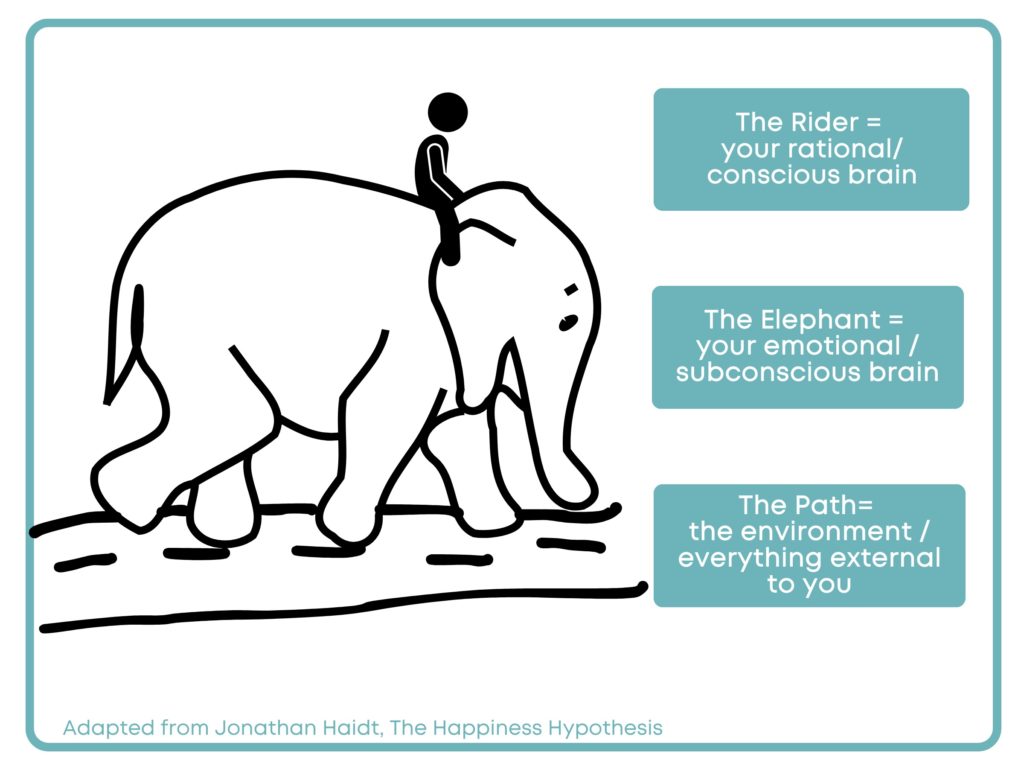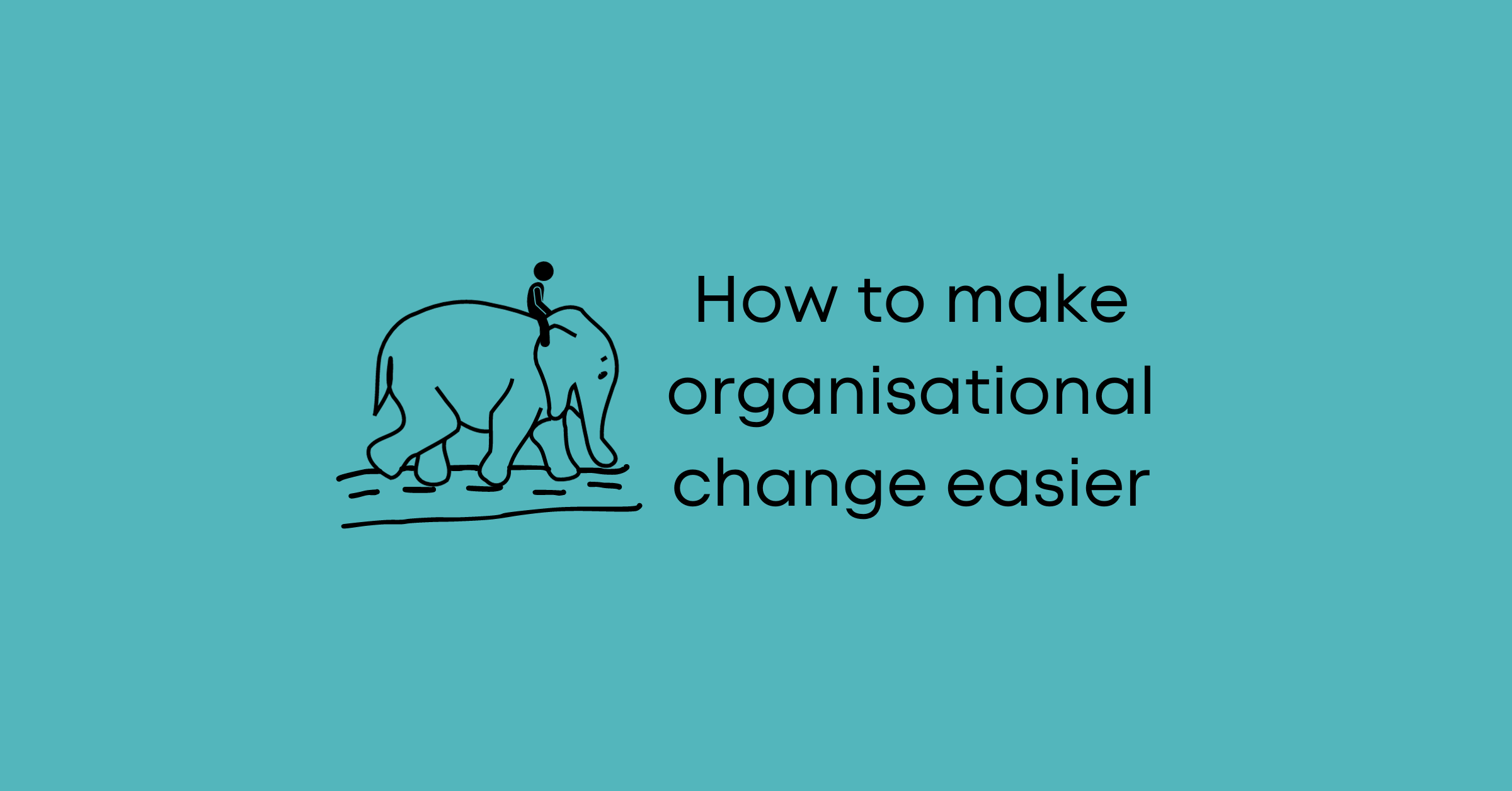There are various change models, but the Elephant, Path, Rider* metaphor stands out for me because it’s easy to understand and mimics how our brains work. In summary it’s about our brains as conscious rider and subconscious elephant that navigate a path — each plays a crucial role in change.
If you are leading change this metaphor will be helpful in considering how to communicate change and which levers to pull and push to get the organisation moving in the right direction.
Imagine a small rider sitting on top of a huge elephant going down a path.
The rider represents the conscious, rational, logical part of our brain. The part that actively thinks thoughts. The rider weighs up pros and cons and makes decisions. It can analyse things, rehearse conversations, do simple problem solving, and plan things out. The rider part of your brain is truly remarkable, and it’s what distinguishes us as humans compared to other species.
But the rider also has its limitations. It can only handle a small amount of information at any one time, and while its processing power of 59 bits of information per second seems fast, it’s nothing compared to other parts of our brain. Also, the rider gets tired easily. You know all this through your own direct experience, when you are learning something new or making lots of decisions you get tired quickly. The rider falls into analysis paralysis unless we give it a break to recharge (and that’s why breaks in the working day are so critical to our performance).
When we launch organisational change, we tend to target all our change communications to the rider. We explain the rationale behind the change and the plan to make the change happen. Our rider loves all this, and it makes a lot of sense to them. So the rider gets all geared up to move forward.
But look at the difference in size between the elephant and the rider. The powerhouse is the 150-tonne elephant. Nothing is really going to happen unless the elephant is motivated to move.

So, let’s meet the elephant.
This is your subconscious, emotional brain (we won’t call it irrational or illogical, because it has its own rationality and logic). It speaks a different language and is altogether a different creature, but it holds the key to any change you want to make. Compared to your rider, it processes more information and at much greater speeds, at around 11 million bits of information per second (compared to the rider’s 59 bits of information per second).
The elephant is particularly skittish, indulgent, fearful and emotional. You know your elephant’s language because it’s the language of metaphors, feelings, stories, and imagery…it’s the language of your dreams at night when the rider is offline (recovering from information overload)….your dreams are all elephant.
We often overlook the language of the elephant in organisational change, but it’s incredibly important. If we want to make change happen and stick, then we need to communicate with the elephant and understand what, and how, it’s being triggered during change. We need to consider both the brakes and the accelerators when it comes to our elephants.
The acronym SCARF (by David Rock “Your Brain at Work”) is a useful tool to consider the elephant’s hot buttons. We trigger almost all of these every time we do organisational change…and then we wonder why change is hard. For more on this see my blog post here.
S = status C = certainty A = autonomy R = relationships F = fairness
If the change being proposed triggers any of these negatively, then the brakes will be put on by the subconscious mind (the elephant). You might get movement, but it won’t last. So when you think about how you communicate a change consider all the above, tick them off one by one, to ensure you are not putting the brakes on the elephant too much.
Once we have addressed the brakes then we can look at what actually gets the elephant moving in the right direction.
Some of the above still apply (for example, we will see movement towards anything that has a promise of higher status or deeper relationships etc), but there are a few more things your elephant needs:
- Positive emotions
- Stories and metaphors
- Visions and imagery
- Simply easy to understand concepts
Emotions and stories play a big role in whether we will buy into something (see my blog post here for the role of storytelling in change). The idea of using negative emotions to drive change (“the burning platform”) is thankfully not used much anymore. The risk of using negative emotions to drive change is that we get elephant either paralysed with fear (nothing happens, no change) or we get movement only until the danger or threat is gone. Unless it is the absolute reality then it’s best to use positive emotions to get elephants moving.
Chip and Dan Heath (in their book How to Change When Change is Hard) use the idea of “postcards from the future” to describe a vision of what the future will look like. This is powerful to our elephants. The more we can use imagery and visions of the future in change the better (remember: dreams are all elephant).
All communication to the elephant has to be simple: elephants don’t do words very well. That’s not to say that words don’t matter, they just need to be simple words that can represent a rich idea.
When we wake up from a dream we often get “a sense or feeling” of the dream without being able to remember the details. We may only remember how it made us feel. That’s another clue as to how your elephant communicates. It’s all about emotion. For every change communication you are scoping consider which emotions you can use to describe how things used to feel, now feel and then will feel in the future.
Lastly, the path that the elephant and rider are walking on, in the model represents the external environment; the culture, ways of working, processes, other people and the physical environment.
The next time you need to lead change, or if you are in the middle of a change program and wondering why things are not going the way you want them to, think about how much focus you are giving to each of the rider, elephant, and path. Often it’s one of these that is not being addressed (and very often it’s the elephant’s need for vision, stories, and emotions that are getting overlooked).
If you need to lead change more effectively or to arrange some change leadership coaching, contact me at Sarah Robertson Consulting or book a discovery call
*The elephant, path, rider model was originally developed by Jonathan Haidt. It’s used here with permission. It was later built on by Chip and Dan Heath in their book How to Change When Change is Hard.


